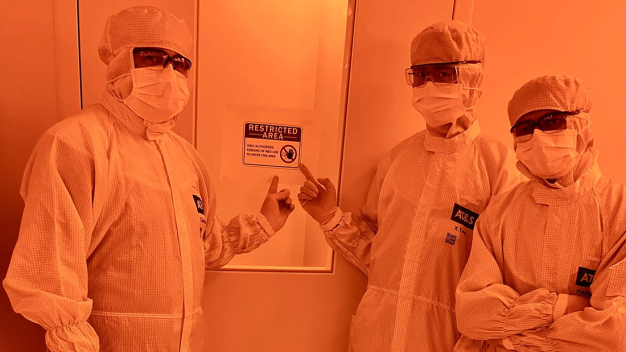- Company
Unique look behind the scenes of AT&S research
The technology leader AT&S already holds almost 800 patents and was giving an insight into its R&D departments in Leoben at the “Long Night of Research” on May 24, 2024. But some things remain top secret: the new research center and Europe’s first substrate plant recently installed a high-tech machine that is unique in the world. It allows the exposure of substrate structures that are 14 times thinner than a human hair.
“No photography” and “Restricted Area” – as if these signs weren’t enough, the high-tech machine is also concealed behind a plastic screen. What stands here in the protective yellow light of the clean room is the pride and joy of the R&D team at the new substrate research center “HTB3” in Leoben.
From the outside, the cube-shaped machine is inconspicuous. And yet: there is no other machine like it in the world and it would cost several million euros to buy – but AT&S has been provided with it by the manufacturer as a prototype for six months for testing purposes. This provides the production company with practical data to make the device ready for series production, and the AT&S engineers have a special tool to carry out invaluable R&D analyses in parallel with production.
The inner workings are spectacular: the machine is an exposure tool for lithography, a so-called Direct Imager, which can expose extremely fine structures in substrate production. In microtechnology, the micrometer is the measure of all things: 1 micrometer (1 μm) is a thousandth of a millimeter. The conductor tracks that can be produced using this exposure device are only 5 μm wide (0.005 mm). By comparison, a human hair is around 70 μm thick (0.07 mm) – and therefore 14 times wider.
The team led by Leoben R&D expert Timo Schwarz has been testing the Direct Imager since May and has carried out countless analyses. The new R&D tool enables a high resolution in combination with greater depth of field, generally more configuration options, unlimited design variations and a faster, more flexible and resource-saving test phase compared to other technologies. “For the first time in Europe, we are researching the further development of our IC substrate technology under near-production conditions, creating added value for us and our partners,” Schwarz is proud of the development in Leoben.
What are substrates?
In simple terms, substrates are reduction couplings from printed circuit boards to the chip. They connect the tiny inputs and outputs of powerful microchips (such as in graphics cards) with the much larger structures of the printed circuit board. Today, substrates are an important basis for all forms of data processing. AT&S already holds almost 800 patents for the manufacture of IC substrates and high-tech printed circuit boards. More than a fifth of the company’s turnover is the result of the innovative strength of AT&S research. “The fact that we not only support top customers with AT&S, but are even development partners for many of them, shows the trust and appreciation that we enjoy with our technological excellence,” says AT&S Head of Research Hannes Voraberger. “Especially in Europe, a focus on research and development of highly complex microelectronics is essential to avoid becoming economically and technologically dependent.”
AT&S CTO Peter Griehsnig also emphasizes the aspects of sustainability: “AT&S’s R&D activities contribute to sustainable development in two ways: Firstly, innovative tools in research work save valuable amounts of time, costs and materials, and secondly, the products created with them ensure more efficient data transmission and smart, green energy efficiency for our end customers.”
AT & S Austria Technologie & Systemtechnik Aktiengesellschaft
8700 Leoben
Austria









